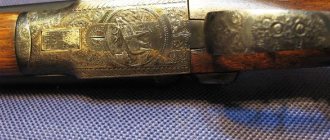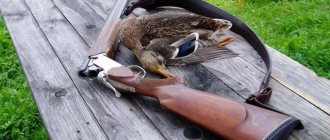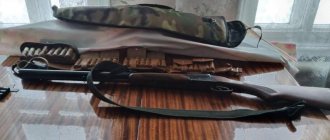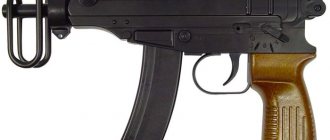This gun is rightfully considered the fatal weapon of the Soviet era, because it gave rise to a new age of guns for hunting. It all started when, after the war, a German copy of the Sauer smoothbore gun ended up in the hands of our gunsmiths. The designers took it as a basis and began developing the IZH-49 gun, radically changing the quality characteristics of existing models. The fact is that the weapons manufacturing plant, located in Izhevsk, has been producing double-barreled shotguns with horizontal barrels since 1933, but nothing good came of it. A lot of problems arose that only complicated operation. Cracks constantly appeared on the stock, fire tubes with strikers were constantly unscrewed.
The IZH 49 shotgun had poor balancing
History of appearance
After the victory over Germany, a hunting rifle from the German armory's model range, number 8, fell into the hands of weapons engineer Sergei Belikov as a trophy. The build quality and design of this trophy model were significantly superior to the prototypes of hunting rifles previously produced at the Izhevsk Mechanical Plant.
In the pre-war period (since 1933), an attempt was made at the Izhevsk Mechanical Plant to master the serial (mass) production of horizontal double-barreled guns. IZHBK and IZH-36 were created, but all these models were doomed to failure. The shapes and design of these hunting firearms were very crude. In addition, during operation, significant design and technological flaws were identified that affected the quality of shooting.
Hunters had many complaints about the new weapon: the stock was constantly cracking due to the loosening of the embedded locks, fire tubes with strikers had to be tightened, and so on.
When was the IZH-49 gun created?
German gunsmiths were superior to Soviet designers in creating hunting rifles in the forties of the twentieth century, so immediately after the war it was necessary to create some new gun that would be superior to existing models.
Thus, in 1950, the production of this hunting rifle began, which did not last long. In 1954, the plant produced the last model, which ended the era of the famous Izhevsk Sauer.
IZH-49. Shotgun of a new formation
The model of hunting weapon is a double-barreled hammer-fired shotgun with a horizontal barrel arrangement of 16 gauge. Stable firing of the gun is ensured by two well-soldered barrel tubes. The barrels are triple locked with two under-barrel hooks.
The firing pins are rigidly combined with the hammers. Only in 1953 did the IZH-49 (see photo in the article) receive a trigger and firing pins with a return action. When opening the gun, the hammers are cocked. The IZH-49 model has an automatic safety lock that protects against accidental pressing. The safety button itself is located on the block shank.
The IZH-49 model provides a smooth trigger release. The handguard has a lever-type latch. The stock of the gun is made of a pistol type. The main external difference of the model range is the straight rear edge of the block, which has a 48 mm pad length. Signal pins (cocked hammer indicators) lie on the side block planes in brass mandrels.
Design
The locks of the IZH-49 gun are cocked by opening the barrel block. The triggers are made as a single unit with strikers. Mainsprings are mounted under the pad pads in special grooves. These same pillows, subjected to intensive testing, are branded with the letter “U”, enclosed in a trapezoidal frame.
The right barrel of the IZH-49 shotgun has a “cylinder” or “polochok” muzzle constriction, the left one has a “choke” or “poluchok” choke. The weight of the barrel block is decent, almost equal in weight to sporting weapons, but due to their own weight, the guns can withstand considerable loads; most examples have survived to this day.
During production, certain changes were made to the design features of the IZH-49 gun. For example, the strikers and triggers, which were originally made as a single unit, became separated and returnable. And if earlier hunters complained that they got a little stuck in the primers, then later the strikers began to return to their original position. The trigger automatically engaged the sear, the firing pin, due to the return spring, was pressed inside the block behind the plane of the shield.
Technical characteristics of IZH-49
Other characteristic features of the model include:
- Hunting rifle weight, kg – 3.2.
- Barrel length, mm – 750.
- Chamber length, mm – 70.
- Diameter of the striker, mm – 2.5.
- Trigger force of the front hook, kg – 1.5-2.5.
- Trigger force of the rear hook, kg – 2-3.
- The size of the muzzle constriction is 12 gauge, mm – 0.5-1.
- The size of the muzzle constriction of the 16th and 20th calibers, mm - 0.45 and 0.8.
- The accuracy of combat is 55-57% for the right barrel and 60-65% for the left.
On mass-produced guns, beech was used as a finish, and for piece production, walnut was used.
At the Moscow International Hunting and Dog Breeding Exhibition in 1950, IZH-49 (photos are presented in the article) was awarded a gold medal (small) and a 1st degree diploma. This achievement of Izhevsk gunsmiths played a huge role in the post-war development of the hunting industry of the Soviet Union. Professionals and amateur hunters got their hands on a reliable and relatively cheap model IZH-49. The price of a gun in 1950 reached 250-300 rubles.
General description of IZH-49
The IZH-49 model is represented by a double-barreled hammer-fired shotgun, 16-gauge barrels, positioned horizontally. Combat stability is ensured by two high-quality welded barrel tubes with triple locking onto a pair of under-barrel hooks. The alignment of the strikers and triggers is tight. From the moment the weapon went on sale, many hunters expressed dissatisfaction that the hard firing pins were tearing the primer, and only in 1953 the situation changed - the IZH-49 gun received triggers with return action firing pins. Cocking occurs the moment the gun is opened.
IZH-49 is equipped with an automatic safety lock that protects against accidental pressing. The safety button is located on the tail of the block. The triggers release smoothly and the forend has a lever latch. The stock is made in a pistol version. Walnut wood was used in the manufacture of it and the forend. The same material was used to make the stock of the IZH-49, on which the factory mark was placed in the form of a heraldic shield, and inside it was a star.
The main external difference of the IZH-49 is that the rear part of the block is cut straight, the cushion reaches 4.8 cm in length. Signal pins indicating that the triggers are cocked lie on the side planes of the block, enclosed in brass alloy mandrels.
The IZH-49 shotgun with a horizontal barrel arrangement and locks in the block and triple locking of the barrel block was created on the basis of a long-tested model with an Anson-Deeley percussion mechanism. Among the new products mastered by the Izhevsk plant by the mid-twentieth century, it took first place in large-scale production. This was facilitated by the necessary equipment for mass production that had appeared at the plant by that time.
In 1950, at the Moscow Hunting and Dog Breeding Exhibition, the IZH-49 shotgun was awarded a small gold medal and a first-degree diploma. The gun played a positive role in the development of the hunting industry of the USSR, putting reliable, relatively cheap weapons into the hands of hunters.
The disadvantages of the IZH-49 model were too much weight, unsatisfactory balance (the center of gravity of ordinary-made guns is 82 mm from the breech end of the barrels), and rough external finish.
The work on creating the IZH-49 and its serial production allowed the plant to accumulate the necessary experience in the design and production of double-barreled shotguns. Based on this experience, taking into account the comments and wishes of hunters, the Izhevsk Mechanical Plant developed a new, more advanced model, the IZH-54 gun, which replaced the IZH-49.
Disadvantages of the IZH-49 model range
In addition to the positive aspects, the model of Izhevsk manufacturers also had negative characteristics. Professional hunters complained that the new gun was too heavy; the use of the product in winter caused particular dissatisfaction. The balancing of the IZH-49 was one of the weakest aspects of the new model and caused many complaints. The center of gravity of the IZH-49 of an ordinary (mass-produced) model was 82 mm from the barrel cut, which was very inconvenient for shooting. We had to constantly take this design feature into account.
The external roughness and low-quality finish of the model did not find due admiration among the user. There were stories and legends about the IZH-49's tendency to misfire. The fact is that when the factory workers copied the European model, they did not take into account the sensitivity of the capsule. Heavy-duty Soviet-made springs deformed thin-walled imported capsule samples.
Advantages and disadvantages
The positive qualities of the IZH-49 gun include the following:
- excellent welding of the barrels guarantees a high-quality fight;
- The barrels come in different lengths, some are even custom-made;
- shooting from paper and metal cartridges is carried out with the same accuracy;
- The automatic fuse increases the level of operational safety.
It would be fair to list the existing disadvantages along with the positive qualities:
- Many hunters pointed out the heavy weight of the weapon; the operation of the IZH-49 caused a lot of dissatisfaction during the winter season. Even then, it became clear to many that the gun needed to be modified or replaced;
- balancing was considered the weakest aspect of the gun and caused a lot of criticism. This drawback interfered with quick aiming, which created serious problems during hunting;
- the center of gravity falls on the 82 mm barrel cut, which is not entirely convenient when shooting - this design feature had to be constantly taken into account;
- the external finishing looks rough and of poor quality and does not evoke due admiration;
- the springs are heavy-duty, the thin-walled primers of imported cartridges are deformed from their impacts.
IZH 49 had an automatic fuse
Future prospects
Thanks to the accumulated experience, the designers and engineers of the manufacturing plant came to the conclusion that there was an urgent need to modernize the IZH-49. Taking into account all the wishes and comments of professional hunters and just hunting enthusiasts, it was decided to release a completely new model. Thus, to replace the IZH-49 in 1955, a new, more improved model was released - IZH-54, which later became more popular than the previous model.
Disadvantages of a hunting rifle
- Large weight is considered one of several negative signs that causes inconvenience when hunting.
- Poor balance is in some way due to the heavy weight. This disadvantage prevents you from quickly aiming a gun, which creates certain problems when hunting.
- The gun's firing pins and their springs are not characterized by good strength, so they often break.
Problems with cracking of the stock, swelling of the barrel at the muzzle and the appearance of shells cannot be called a disadvantage of the IZH-49 gun, since these problems can arise with every hunting rifle if all operating rules are not followed.
Legendary models of the Izhevsk plant
Over its more than 70-year history, Izhevsk Mechanical Plant OJSC has produced a huge number of hunting and sporting small arms. Today, the volume of production exceeds 750 thousand weapons per year. The most successful models are a source of pride for factory workers. Here are the TOP 5 legendary hunting small arms that brought fame and success to Izhevsk gunsmiths:
- IZH-12. Double-barreled hammer-fired shotgun, model 1962-1974.
- IZH-49. The model was manufactured in 1950-1954.
- IZH-59 "Sputnik". Reliable double-barreled shotgun from 1960-1964.
- IZH-26. The production of the model range was mastered in 1970-1975. This model has received great appreciation in the international market.
- IZH-58. The model was mastered in 1958.

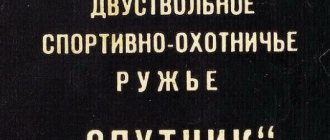
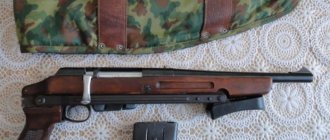
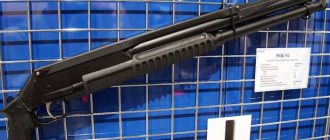
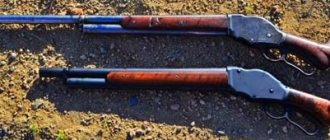
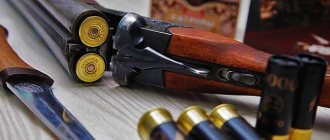
!['Domestic small arms [studio "Wings of Russia"] (2011)'](https://knifesburg.ru/wp-content/uploads/otechestvennoe-strelkovoe-oruzhie-studiya-krylya-rossii-2011-330x140.jpg)

